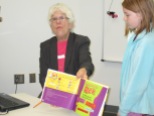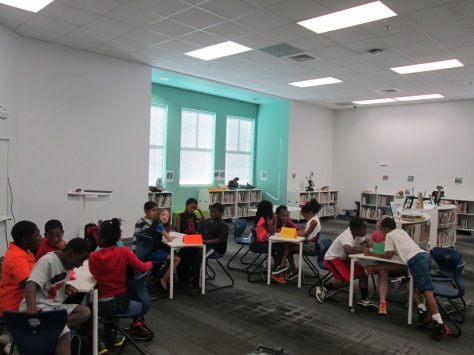
Our student book budget team is still hard at work compiling consideration lists to match their goals. Today, they met as grade levels with Gret Hechenbleikner from Gumdrop Books. This year, we are using 3 vendors for our purchasing. Students already met with Jim Boon from Capstone Press, and they will meet with Will Walton from Avid Bookshop later this week.
Our process with Gumdrop was slightly different than Capstone since Gumdrop doesn’t have a scan to cart feature or a catalog. Instead, Gret brings a selection of books for students to look at. Inside each book, she has list of the other books that are found in that same series. Students can get a taste for what the book looks and feels like and consider whether they might like other books in that same series. Gret brought multiple books that matched the goals that students had set based on our survey data. I sent these goals to her a couple of weeks in advance.
Gret did a quick intro of what she had brought and told students about the lists inside each book. She setup her computer and printer at a table and students started looking at all of the books. She and I both walked around and talked with students about what they were looking at and asked them to consider whether or not students at our school would enjoy the book they were looking at. When students found a book or set of books they wanted to add to our consideration list, they took it to Gret at her computer. She was able to pull up the complete series on her computer, check to see if we already had the book in our collection, and add it or a set of books to our consideration list. When books came up that we already had, Gret and I asked them to think about whether we might need an additional copy. Most of the time students said no, but they did decide to add another Frozen drawing book to our list.
Every 30 minutes a new group of students came to meet with Gret. We even had a few random students who dropped by the library to check out books who offered their own feedback. When all students were done, Gret printed a master list for us to talk about when we meet our budget. She will also email me a PDF of the list that I can manipulate.
I always love this process of meeting with vendors because I put all of my trust in the students. Even when a vendor may ask me about things I want to add to the collection, I remind them that this is completely up to the students. I’ll do my purchasing with other money and other lists.
Students have quite a job to do next week. We currently have 2 different lists which total more than $3,000 each and we have one more vendor to meet with. Our $5,000 budget, which is a grant through the James Patterson Partnership, will definitely not be enough to purchase all that they want, so some tough decisions will have to be made. This is all an important part of the process.



























































![FireShot Screen Capture #020 - 'Edit form - [ Storybook Presidential Election ] - Google Docs' - docs_google_com_a_clarke_k12_ga_us_spreadsheet_gform_key=0Ap88RNajIVy5dFEwXzFXbHFjamN](https://barrowmediacenter.files.wordpress.com/2012/10/fireshot-screen-capture-020-edit-form-storybook-presidential-election-google-docs-docs_google_com_a_clarke_k12_ga_us_spreadsheet_gform_key0ap88rnajivy5dfewxzfxbhfjamn.png?w=300&h=168)








